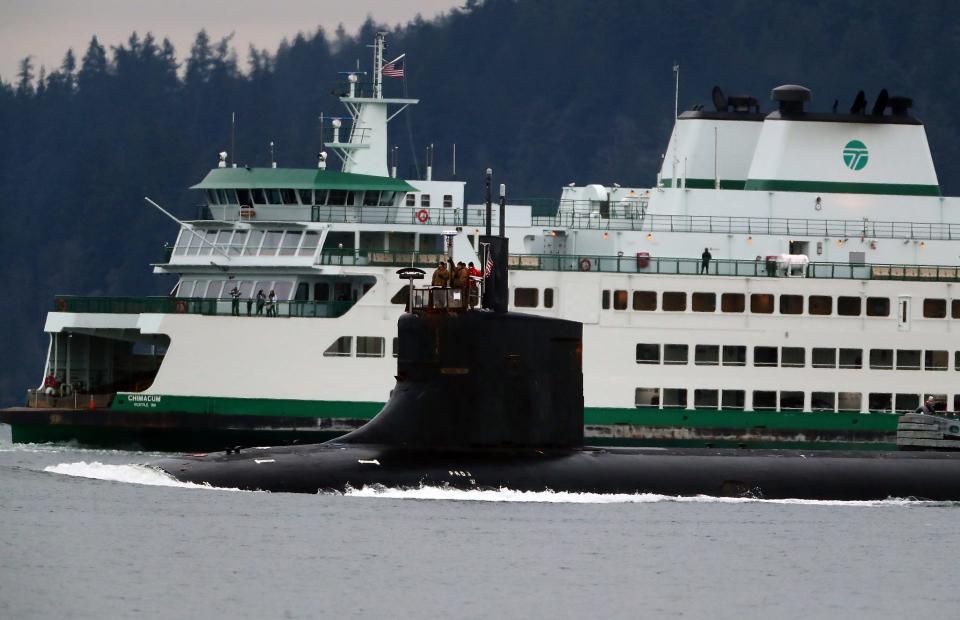USS Connecticut completes 7,000-mile journey to homeport after October crash in South China Sea
BREMERTON, Wash. — A dome-less USS Connecticut sailed into its homeport Tuesday, the end of a 7,000-mile journey following a harrowing collision with an underwater mountain.
The elite sub, one in a three-boat class that's the most advanced the U.S. Navy has ever built, pulled into Naval Base Kitsap-Bremerton for what's expected to be a lengthy period of repairs at the Puget Sound Naval Shipyard.
The Connecticut struck an uncharted seamount in the disputed waters of the South China Sea on Oct. 2. Eleven sailors were hurt in the crash, and two sustained what the Navy described as "moderate" injuries beyond cuts and scrapes. Both crew members were treated and didn't require hospitalization.
The Navy, with the help of personnel from the Puget Sound Naval Shipyard, made repairs in Guam prior to the boat's arduous crossing on the surface of the Pacific Ocean to Bremerton. The Navy confirmed the boat's nuclear reactor and propulsion plant were not damaged in the collision.

By the time Connecticut arrived in San Diego, public cameras captured the results of the crash: A boat that appeared to be missing its sonar dome on its hull. As it arrived in Bremerton, the void appeared.
It will likely be a long time, a period of years, before the Connecticut is ready to deploy again. In 2005, the USS San Francisco, a Los Angeles-class fast-attack submarine, also struck an underwater mountain, a crash that killed a sailor and injured 97 others. It took 3 1/2 years in Puget Sound to install a sonar dome from the decommissioned USS Honolulu, in maintenance that in total cost $134 million.
FACT? CHECKED: Make sure you have the real story with the Checking the Facts newsletter
There is $50 million in the 2022 National Defense Authorization Act for the repairs, Forbes reported Tuesday.
The crash led Vice Adm. Karl Thomas, commander of the Japan-based U.S. 7th Fleet, to relieve Cmdr. Cameron Aljilani as commanding officer, Lt. Cmdr. Patrick Cashin as executive officer, and Master Chief Sonar Technician Cory Rodgers as chief of the boat, due to a loss of confidence in their command.

The South China Sea, where China has been developing military bases on artificial reefs in disputed waters, is largely unmapped outside of satellite imagery. Deborah Kelly, an oceanography professor at the University of Washington, told the Kitsap Sun of the USA TODAY Network that her review of the sea shows that it is shallow, has "lots of little pinnacles on the seafloor," and is subject to the noise of shipping vessels that "might make it harder to image things" with sonar.
The Connecticut is one of three of the Seawolf-class, built in the era of the Cold War for $3 billion apiece. Armed with about 50 torpedoes fired from eight different tubes, the subs are also stealthily quiet and the fastest ever built, ideal for covert missions. The Connecticut and sister ship USS Seawolf are homeported in Bremerton until the Navy completes a $90 million pier at Naval Base Kitsap-Bangor; then, after repairs, the two subs will be able to join the USS Jimmy Carter, the third Seawolf, there.
Josh Farley is a reporter covering the military and Bremerton for the Kitsap Sun. He can be reached at 360-792-9227, josh.farley@kitsapsun.com or on Twitter at @joshfarley.
This article originally appeared on Kitsap Sun: USS Connecticut returns home after October crash in South China Sea

